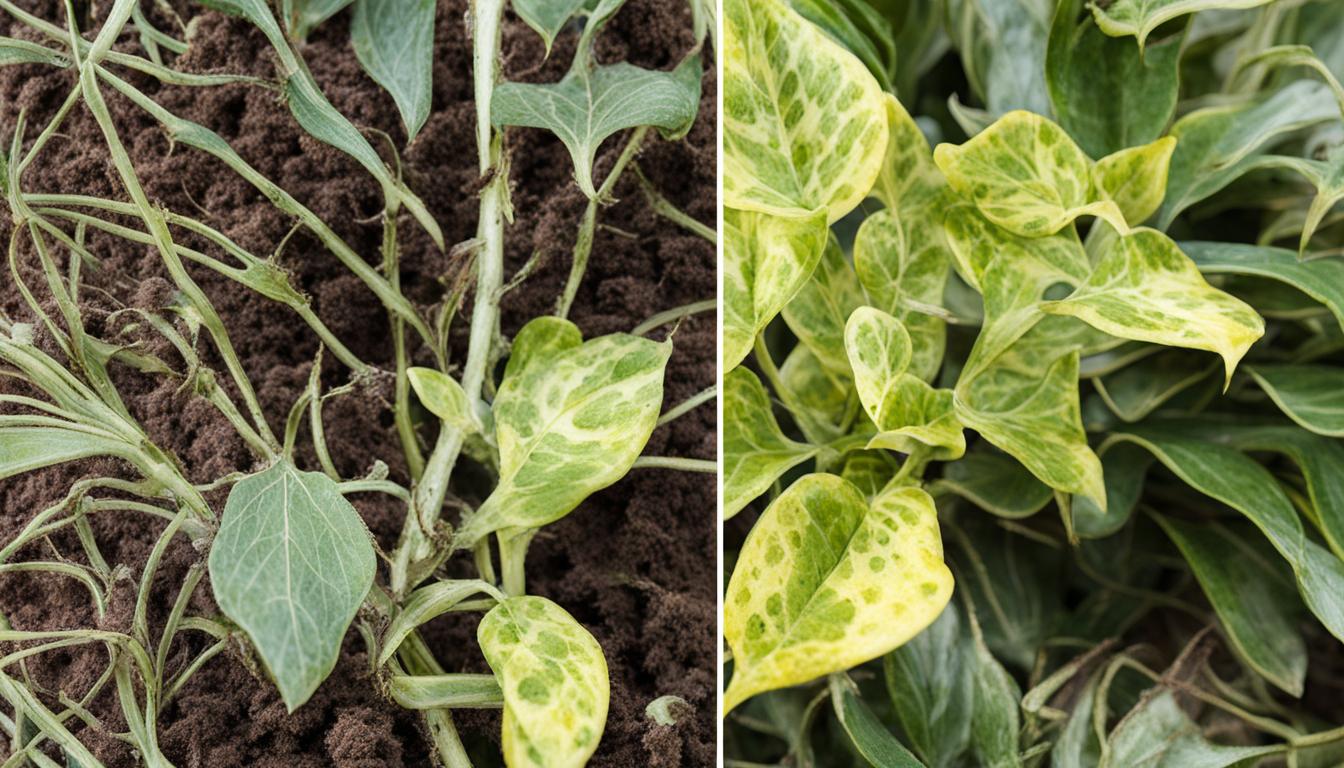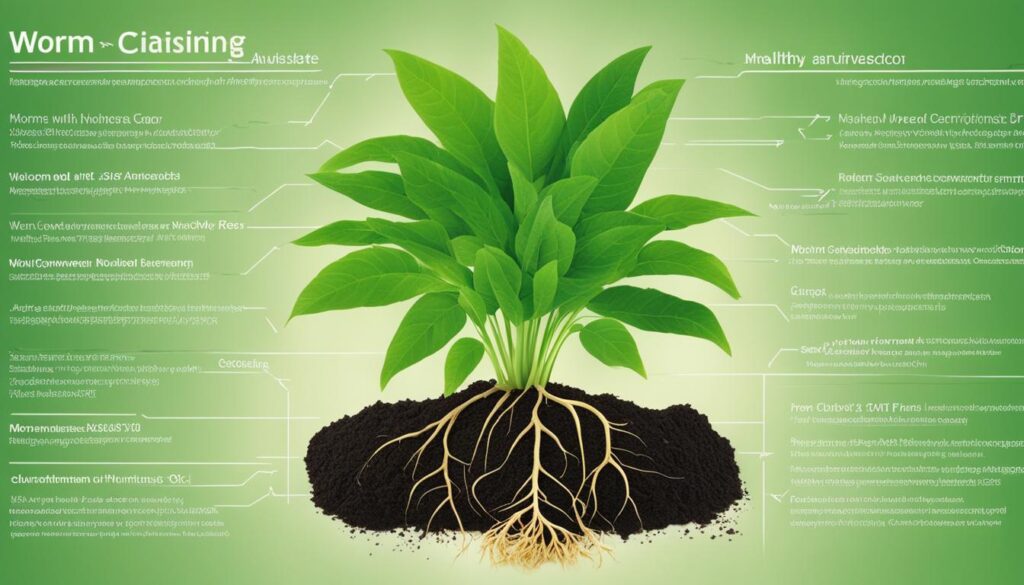
Micronutrient deficiency in plants refers to the insufficient quantity of essential nutrients required for plant growth and development.
Plants need 16 essential nutrients to grow properly, including macronutrients like nitrogen, phosphorus, potassium, sulfur, calcium, and magnesium, and micronutrients like copper, manganese, zinc, iron, boron, and molybdenum.
Micronutrient deficiencies can lead to various symptoms in plants and adversely affect their overall health and productivity.
Key Takeaways:
- Micronutrient deficiency in plants results from a lack of essential nutrients necessary for their growth and development.
- Plants require 16 essential nutrients, including macronutrients and micronutrients.
- Common micronutrients include copper, manganese, zinc, iron, boron, and molybdenum.
- Micronutrient deficiencies can cause various symptoms in plants, affecting their health and productivity.
- Addressing and preventing micronutrient deficiencies is crucial for maintaining healthy and productive plants.
Common Symptoms of Micronutrient Deficiency in Plants
When plants experience micronutrient deficiencies, they often exhibit common symptoms that can help identify the specific nutrient that is lacking. These symptoms can manifest in various ways, including discoloration and distortion of leaves and stems.
By recognizing these signs, gardeners and farmers can take proactive measures to address the deficiencies and promote healthy plant growth.
One common symptom of micronutrient deficiency is the yellowing or bronzing of leaves. This discoloration typically occurs in specific patterns and can affect both old and new leaves.
Another symptom is interveinal chlorosis, which is the yellowing of the tissue between leaf veins. Stunted growth is often observed in plants with micronutrient deficiencies, as well as the development of necrotic spots or patches on leaves. In some cases, the leaves may become twisted or misshapen, indicating a micronutrient deficiency.
It is important to note that the specific symptoms can vary depending on the type of micronutrient deficiency and the plant species affected. Each nutrient deficiency has its own unique set of symptoms, which can help guide the diagnosis and treatment.
By carefully observing these symptoms and comparing them to known deficiency indicators, gardeners and farmers can accurately identify micronutrient deficiencies and take appropriate measures to address them.
Table: Symptoms of Micronutrient Deficiency in Plants
| Micronutrient | Common Symptoms |
|---|---|
| Iron | Interveinal chlorosis (yellowing between leaf veins) |
| Zinc | Shortened internodes, small leaves, and interveinal chlorosis |
| Manganese | Interveinal chlorosis, necrosis, and leaf deformation |
| Copper | Leaf wilting, reduced growth, and dieback |
| Boron | Brittle leaves, bud necrosis, and root tip dieback |
By recognizing the common symptoms of micronutrient deficiencies and referring to informative tables like the one above, gardeners and farmers can effectively diagnose and address micronutrient deficiencies in plants, ensuring their health and productivity.
Causes of Micronutrient Deficiency in Plants
Micronutrient deficiency in plants can have several causes, which can impact agricultural practices and the overall health of plants. Understanding these causes is crucial for effectively addressing and preventing micronutrient deficiencies in agriculture and soil. Some of the key factors contributing to micronutrient deficiency in plants are as follows:
- Depleted agricultural soils: Continuous farming, high-yield crop production, and inadequate nutrient management practices can lead to the depletion of essential micronutrients in the soil. Over time, this can result in micronutrient deficiencies in plants.
- High analysis fertilizers: The widespread use of high analysis fertilizers that focus primarily on macronutrients can neglect the essential micronutrients required for plant growth. These fertilizers may not provide an adequate supply of micronutrients, leading to deficiencies in plants.
- Soil preparation practices: Certain soil preparation practices, such as intense plowing or tilling, can remove the nutrient-rich topsoil, which contains a significant portion of the plant’s required micronutrients. This can result in lower levels of micronutrients available for plant uptake.
- Nutrient imbalances: Imbalances in nutrient levels, particularly excess phosphorus, can interfere with the uptake and utilization of micronutrients by plants. High levels of phosphorus can induce deficiencies in certain micronutrients, even if they are present in the soil.
It is important for farmers and growers to consider these causes when developing nutrient management strategies and addressing micronutrient deficiencies in their crops.
By understanding the underlying causes, appropriate measures can be taken to ensure healthier plants and maximize agricultural productivity.
Table: Comparison of Micronutrient Deficiency Causes
| Cause | Description |
|---|---|
| Depleted agricultural soils | Continuous farming and inadequate nutrient management practices lead to the depletion of essential micronutrients in the soil. |
| High analysis fertilizers | The use of fertilizers focusing primarily on macronutrients neglects the essential micronutrients required for plant growth. |
| Soil preparation practices | Intense plowing or tilling removes nutrient-rich topsoil, reducing the availability of micronutrients for plant uptake. |
| Nutrient imbalances | Imbalances in nutrient levels, especially excess phosphorus, can interfere with the absorption and utilization of micronutrients by plants. |
Treating Micronutrient Deficiency in Plants
Treating micronutrient deficiency in plants is essential to ensure their optimal growth and productivity. By supplying the deficient nutrients in a form that is readily available and easily absorbed by plants, we can effectively address the deficiencies and promote healthy plant development.
One approach to treating micronutrient deficiency is through the application of fertilizers or nutrient solutions containing the specific nutrient that is lacking.
For example, if a plant is deficient in iron, iron sulfate or chelated iron can be added to the soil or sprayed onto the foliage to provide the necessary iron. It is important to match the deficiency symptoms with the correct nutrient and apply it at the recommended dosage to ensure effective treatment.
In addition to fertilizers, soil amendments like compost or manure can also play a valuable role in treating micronutrient deficiencies. These organic materials slowly release micronutrients into the soil, providing a steady supply over time.
Incorporating them into the growing medium can help replenish depleted nutrient levels and improve overall plant health.
When treating micronutrient deficiencies, it is crucial to consider the specific needs of different plant species and their unique responses to nutrient availability.
Consulting with plant nutrition experts can provide valuable insights and guidance on the most effective treatment strategies for specific crops or plants.
Treating Micronutrient Deficiency – Summary
- Supply deficient nutrients through fertilizers or nutrient solutions
- Match deficiency symptoms with the correct nutrient
- Apply the recommended dosage for effective treatment
- Utilize soil amendments like compost or manure for long-term nutrient supply
- Consider plant species’ unique nutrient requirements when treating deficiencies
- Consult with plant nutrition experts for tailored treatment strategies
Table: Common Micronutrient Deficiencies and Treatment Methods
| Micronutrient | Common Deficiency Symptoms | Treatment Methods |
|---|---|---|
| Iron (Fe) | Interveinal chlorosis, yellowing leaves | Iron sulfate, chelated iron |
| Zinc (Zn) | Stunted growth, malformed leaves | Zinc sulfate, zinc chelates |
| Manganese (Mn) | Yellowing between leaf veins | Manganese sulfate, manganese chelates |
| Copper (Cu) | Dieback, wilting | Copper sulfate, copper chelates |
| Boron (B) | Brittle leaves, bud death | Boron fertilizer, borax |
Preventing Micronutrient Deficiency in Plants

Preventing micronutrient deficiency in plants is crucial for ensuring their healthy growth and optimal productivity. By implementing a few key practices, you can create a balanced and nutrient-rich environment for your plants to thrive. Here are some effective strategies:
Regular Soil Testing
Regular soil testing is essential to assess the nutrient levels and pH of your soil. This information helps you make informed decisions about the specific micronutrients your plants may need.
Based on the test results, you can incorporate micronutrient-rich fertilizers or soil amendments into the growing medium to maintain optimal nutrient levels.
Proper Fertilization
Proper fertilization is crucial for preventing micronutrient deficiencies. It’s important to use fertilizers that contain a balanced mix of both macronutrients and micronutrients.
Following recommended fertilization practices, such as applying the right dosage at the right time, can ensure that your plants receive a steady supply of essential nutrients.
Monitoring pH and Nutrient Levels
Monitoring the pH and nutrient levels of your soil is essential for preventing micronutrient deficiency. Different micronutrients are best absorbed by plants at specific pH levels.
By regularly testing and adjusting the pH of your soil, you can create an optimal environment for nutrient uptake. Additionally, monitoring nutrient levels allows you to address imbalances promptly and provide any necessary supplements.
By following these preventive measures, you can provide your plants with the necessary micronutrients for their healthy growth and development. This will not only enhance their overall health and appearance but also maximize their productivity.
Diagnosing Micronutrient Deficiency in Plants

When it comes to diagnosing micronutrient deficiency in plants, careful observation of symptoms is key. By comparing these symptoms with known deficiency indicators, we can accurately identify the nutrient deficiencies and take appropriate action.
Leaf discoloration patterns, growth abnormalities, and specific symptoms associated with each micronutrient deficiency can provide valuable clues for diagnosis.
It is important to consider the specific nutrient requirements of different plant species when diagnosing micronutrient deficiencies. Each plant may exhibit unique symptoms depending on its nutritional needs.
Soil testing and nutrient analysis can also play a crucial role in diagnosing deficiencies, providing insights into the key nutrients that may be lacking in the soil.
Consulting with plant nutrition experts can further enhance the accuracy of diagnosis. These experts have extensive knowledge and experience in identifying and addressing micronutrient deficiencies in plants.
Their expertise can help guide us in implementing the right measures to treat and prevent deficiencies, ensuring the overall health and productivity of our plants.
| Micronutrient | Common Symptoms |
|---|---|
| Copper | Leaf chlorosis, stunted growth |
| Manganese | Interveinal chlorosis, leaf necrosis |
| Zinc | Shortened internodes, small leaves |
| Iron | Yellowing leaves with green veins |
| Boron | Brittle leaves, distorted growth |
| Molybdenum | Leaf curling, poor nodulation in legumes |
By understanding the symptoms and utilizing the expertise available, we can accurately diagnose micronutrient deficiencies in plants. This knowledge allows us to take targeted action and provide the necessary nutrients to ensure the health and vitality of our plants.
Reliable Solutions for Healthier Plants
When it comes to promoting healthier plants and preventing micronutrient deficiencies, there are several reliable solutions that can make a significant difference. By implementing these strategies, you can ensure optimal growth and maximize the productivity of your plants.
1. Regular Soil Testing: Conducting regular soil testing is crucial in determining the nutrient levels and pH of your soil. This information helps you identify any deficiencies and adjust fertilization practices accordingly.
2. Proper Fertilization: Maintaining a balanced nutrient supply is essential for plant health. By using fertilizers that contain the necessary micronutrients, you can provide your plants with the vital elements they need for optimal growth and development.
3. Integrated Nutrient Management: Implementing integrated nutrient management strategies, such as incorporating organic matter and compost into your soil, can greatly improve soil fertility and micronutrient availability. This promotes a healthier growing environment for your plants.
4. Good Irrigation and Drainage Management: Proper irrigation and drainage practices are crucial in preventing micronutrient deficiencies. Ensuring that your plants receive the right amount of water, while avoiding excessive waterlogging, helps maintain a healthy balance of nutrients in the soil.
By following these reliable solutions and consulting with plant nutrition experts, you can create an ideal environment for your plants to thrive. Remember, healthier plants are more resistant to diseases and pests, resulting in increased productivity and overall success in your gardening or agricultural endeavors.
FAQ
What is micronutrient deficiency in plants?
Micronutrient deficiency in plants refers to the insufficient quantity of essential nutrients required for plant growth and development.
What are the common symptoms of micronutrient deficiency in plants?
Common symptoms include leaf discoloration or distortion, yellowing or bronzing of leaves, interveinal chlorosis, stunted growth, leaf necrosis, and twisted or misshapen leaves.
What causes micronutrient deficiency in plants?
Micronutrient deficiencies can be caused by depletion of nutrients in soil, absence of micronutrients in fertilizers, land preparation practices, high levels of other nutrients, soil pH, moisture levels, temperature, and nutrient imbalances.
How can micronutrient deficiency in plants be treated?
Micronutrient deficiency in plants can be treated by supplying the deficient nutrient through fertilizers, nutrient solutions, or soil amendments like compost or manure.
How can micronutrient deficiency in plants be prevented?
Micronutrient deficiency in plants can be prevented by maintaining a balanced and nutrient-rich growing environment, regular soil testing, adjusting pH and nutrient levels, and practicing good irrigation and drainage management.
How can micronutrient deficiency in plants be diagnosed?
Micronutrient deficiency in plants can be diagnosed by observing symptoms, comparing with known deficiency indicators, considering plant species requirements, and conducting soil testing and nutrient analysis.
What are reliable solutions for healthier plants?
Reliable solutions for healthier plants include implementing integrated nutrient management strategies, proper fertilization practices, consulting with plant nutrition experts, and following recommended best practices.






